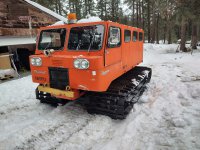WestWind1
New member
Hey all,
First post on this forum, but I have been reading threads on here for a bit and everyones knowledge and love for these machines is really awesome to see! Last summer I purchased a 1979 Thiokol 1200C, the intended use is to access remote areas for backcountry skiing (I run a backcountry ski guiding business and we are in the final stages of getting our permits for mechanized access ski touring in a fe remote areas around Tahoe). We are getting ready to take it out on our first personal trip into the mountains, we will only be operating on groomed trails and existing OSV routes. I have a decent understanding of vehicles and mechanics and have given it a basic tune up and once over: Fresh fluids, new spark plugs, carb clean, etc.. and it seems start fine and run well doing a few laps around the driveway. I would like to know if there is anything specific to these machines that I should check or look out for before taking it out? I have spent a good bit of time in snowcats over the years, but mostly newer machines at ski resorts. Also, what are people carrying for field repair besides a basic tool set? It did come with an extra master cylinder and I am curious what else I should be carrying in case of a mechanical failure? I have attached a photo of cat for everyone to enjoy. Thanks in advance!
First post on this forum, but I have been reading threads on here for a bit and everyones knowledge and love for these machines is really awesome to see! Last summer I purchased a 1979 Thiokol 1200C, the intended use is to access remote areas for backcountry skiing (I run a backcountry ski guiding business and we are in the final stages of getting our permits for mechanized access ski touring in a fe remote areas around Tahoe). We are getting ready to take it out on our first personal trip into the mountains, we will only be operating on groomed trails and existing OSV routes. I have a decent understanding of vehicles and mechanics and have given it a basic tune up and once over: Fresh fluids, new spark plugs, carb clean, etc.. and it seems start fine and run well doing a few laps around the driveway. I would like to know if there is anything specific to these machines that I should check or look out for before taking it out? I have spent a good bit of time in snowcats over the years, but mostly newer machines at ski resorts. Also, what are people carrying for field repair besides a basic tool set? It did come with an extra master cylinder and I am curious what else I should be carrying in case of a mechanical failure? I have attached a photo of cat for everyone to enjoy. Thanks in advance!

